Überclok Reactor: Balanced Performance
by Matt Campbell on October 10, 2008 12:00 AM EST- Posted in
- Systems
Specifications
The specifications below are for the system as tested. Our original review system actually shipped with a GeForce 9800 GX2, which seemed stable until we started doing some of the 3D testing and it began a rapid decline to the dead parts box. We contacted Überclok and they provided us with a GTX 280 as a replacement, which is an available configuration option on the Reactor. However, some recent changes have made the current Reactor slightly different from the review system shown below, which we will discuss in the Pricing section.
| Uberclok Reactor System Specifications | |
| Processor | Intel Core2 Quad Q9450 |
| Motherboard | EVGA nForce 780i |
| Memory | 2x2GB G.Skill DDR2-1066 |
| Video Card | NVIDIA GeForce GTX 280 |
| Power Supply | Cooler Master CMPSU 1000W |
| Case | Cooler Master Cosmos S |
| Hard Drive | Seagate 500GB, Western Digital 300GB |
| OS | Windows XP Professional Windows Vista Home Premium 64-bit (dual-boot) |
| DVD Burner | LG Blu-Ray/HD-DVD and Burner, Lite-On DVDRW |
| CPU Cooler | Xigmatech HDT-S1283 |
Exterior
Once again, the system arrived in a plain cardboard box with some Überclok stickers on it. The Cooler Master Cosmos S is encased within it its own product box and bag.
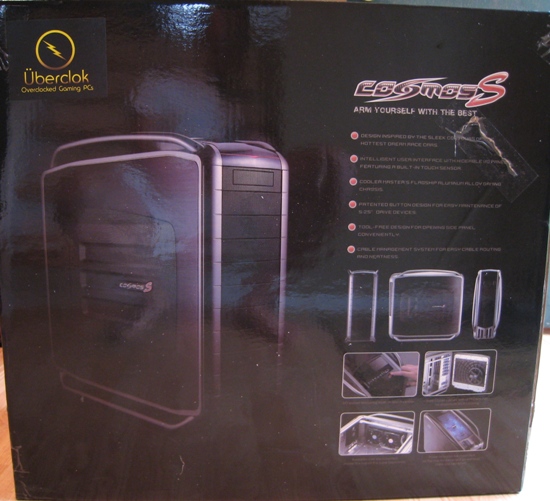
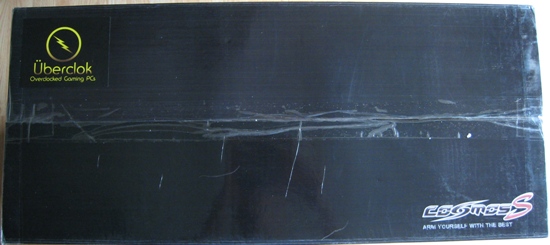
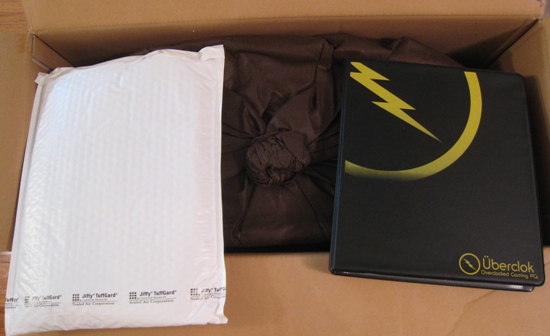
Nothing too interesting here - the case box is well cushioned and arrived undamaged. The owner's manual is still very well-done and a great addition at this price point. We do wish they'd include just a few performance benchmarks in the opening pages. Those results can serve as a baseline measurement, so if you find your system scores i.e. 10000 in 3DMark06 and the initially shipping system scored 12000, you know it's time for a tune-up.
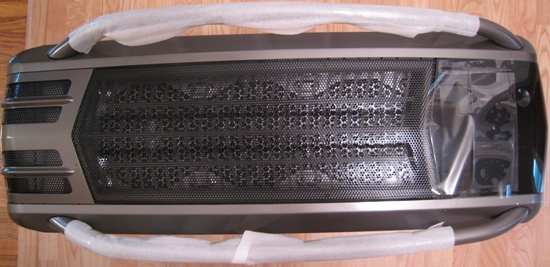

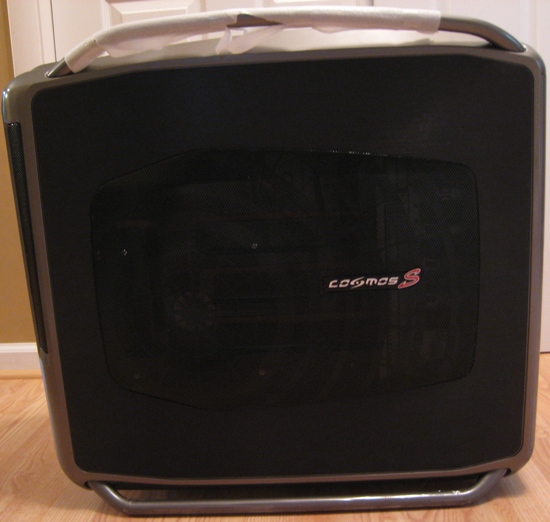
Interior
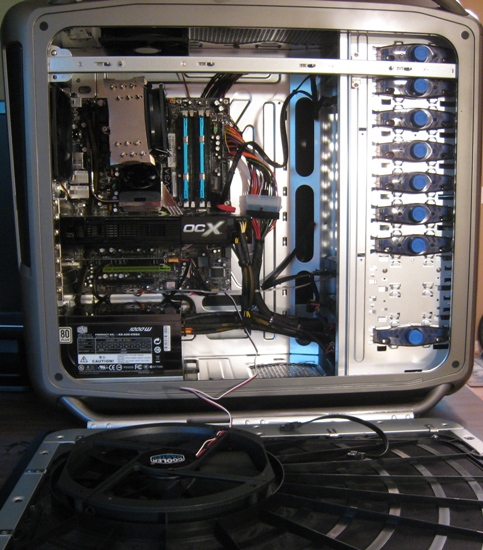
The Cosmos S has a monster (200mm) fan on the side.
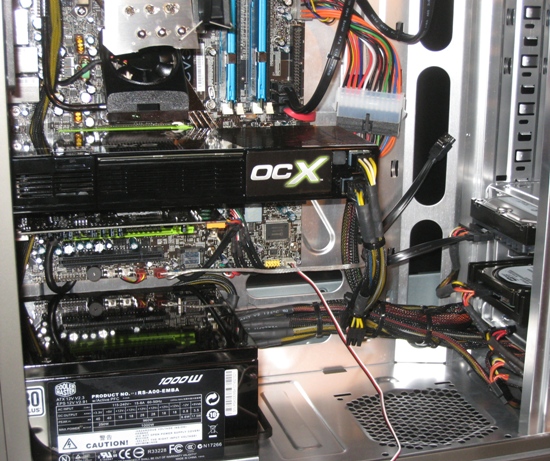
Wire management is reasonably good, as it was with the Ion.
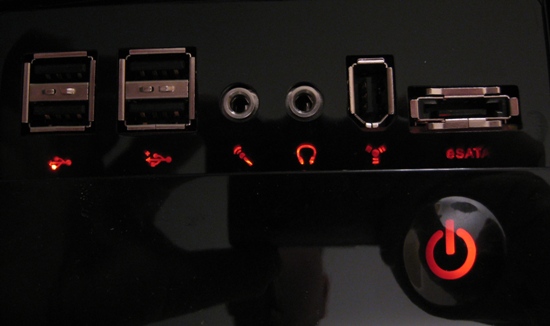
The button on the Cosmos S is interesting - it's essentially just a depression on the case that's touch sensitive. Once you get the hang of it, it works reasonably well, though it's a little twitchy at times for our taste. It's difficult to see from the pictures, but the Cooler Master power supply has a nice mirror finish.










30 Comments
View All Comments
7Enigma - Friday, October 10, 2008 - link
I said it in the Ion review and I'll say it again, this pseudo heatpipe/water cooling thing is just plain junk. I'm sure something like the Tuniq or even cheaper standard heatsink/fan combo's would produce better results. The problem with this cooling system is there just isn't enough reserve liquid, or contact time with the fan-cooled area. Make one or the other larger and the performance should go up a bit, but I just think it's a gimmick for show, a bit of form over function if you will.And thank you Christopher for bringing up the PSU. Without checking Anand's old articles, have you guys reviewed this exact PSU system? I'd be very interested to see just how badly the efficiency is due to being 20-30% of rated output for the majority of the time. A 650w PSU would have been perfect for this system, allowing for further OC'ing or added components while keeping the total cost down and possibly greater efficiency of the PSU.
Uberclok - Friday, October 10, 2008 - link
>>>A 650w PSU would have been perfect for this system, allowing for further OC'ing or added components while keeping the total cost down and possibly greater efficiency of the PSU<<<We always want to ship single card systems with the possibility of adding a second GPU later without upgrading the PSU. Offering the Reactor with a 650-Watt PSU and marketing it as ready to run a pair of HD 4870 X2 would get us assassinated in the reviews. We wish marketing issues never got in the way of efficient design, but that's the reality of retail.
The Corsair 1000-watt is not horrifically overpriced, and it sets minds at ease. It adds $50 to the cost over the Thermaltake Toughpower 650-Watt modular PSU we've used in the past.
Uberclok - Friday, October 10, 2008 - link
>>>his pseudo heatpipe/water cooling thing is just plain junk.<<<I think you must have mistaken our CPU cooler for another product. The Xigmatek HDT-S1283 is an air cooler - very similar to the Tuniq Tower 120. There's no liquid involved. It performs almost as well at a lighter weight, which is crucial wehn you're shipping cross-country. The Ion you refer to also uses the same cooler.
icingdeath88 - Friday, October 10, 2008 - link
Ok, well since I'm using the HDT-S1283 as well, I have to ask you guys, because I just could not figure it out. How did you apply the thermal compound? There just doesn't seem to be any perfect way, what with the heatpipes involved rather than the usual flat surface.Thanks
JarredWalton - Friday, October 10, 2008 - link
At idle, efficiency is likely to be very poor, but at load it should get very good efficiency. I'm not saying it's an exact match (because I'm sure it isn't), but as an example the http://www.anandtech.com/casecoolingpsus/showdoc.a...">Zalman 1000W is above 83% efficiency with 120VAC from a load of 200W to 800W, and above 80% from around 150W to 1100W. If we take a baseline 80%, at 195W from the outlet the system idles at 156W, and at medium load it will use over 200W (so above 83%). That's of course assuming this is a good PSU, which I have no reason to doubt -- nearly all of the 1000W PSUs come from one or two ODMs, and with higher margins they also tend to use good components.7Enigma - Friday, October 10, 2008 - link
I'm just saying with most computers spending the majority of their time at idle/near-idle, it doesn't make a lot of sense. And that's not even mentioning the hundreds of dollars you could save (though lower margins likely for the company) for the piece itself. The few that do FAH and other idle-cycle programs are probably not being used by the target consumer of this computer.7Enigma - Friday, October 10, 2008 - link
The closest reviewed product I could find was another Corsair 1000w but it has a slightly different model number (you reviewed back in April of this year). Here's the direct link to the picture showing the efficiency:http://images.anandtech.com/reviews/psu/2008/corsa...">http://images.anandtech.com/reviews/psu/2008/corsa...
Seems like around idle (where the computer will spend most of it's time) it's closer to 80% efficient, while under load it get's up to closer to 85%. Again the model numbers don't match up exactly, but the general trend should be pretty consistent (ie doing little it's pretty inefficient).
7Enigma - Friday, October 10, 2008 - link
Sorry for the double post, I got an error page and thought the comment hadn't been submitted. Feel free to delete this and the previous duplicate post!Christoph Katzer - Saturday, October 11, 2008 - link
http://images.anandtech.com/reviews/psu/2007/round...">http://images.anandtech.com/reviews/psu...oundup-8...here you can find some more 1000 watts units. The Cooler Master PSU should come close to the Antec and Akasa units.
7Enigma - Friday, October 10, 2008 - link
The closest reviewed product I could find was another Corsair 1000w but it has a slightly different model number (you reviewed back in April of this year). Here's the direct link to the picture showing the efficiency:http://images.anandtech.com/reviews/psu/2008/corsa...">http://images.anandtech.com/reviews/psu/2008/corsa...
Seems like around idle (where the computer will spend most of it's time) it's closer to 80% efficient, while under load it get's up to closer to 85%. Again the model numbers don't match up exactly, but the general trend should be pretty consistent (ie doing little it's pretty inefficient).